Data Mining Archaeogenetic and Linguistic Data Gives an Improved Chronology of the Uralic Language Family
Abstract
1. Introduction
1.1. Why the Contradition Between Archaeogenetics and Linguistics Is Harmful?
1.2. Why Chronology and the Location of the Homeland Are Still Big Questions?
1.2.1. From the Danube Basin to the Urals?
1.2.2. From the Urals to the Danube Basin?
1.3. The Main Goals of This Paper
- We show that the Danube Basin to the Urals is the correct direction of the spread of the Uralic languages. We show that the interpretation of Török [24] is mathematically inconsistent with the admixture data presented in Maróti et al. [25]. We also argue against some other recent theories that place the homeland in Siberia.
- We derive archaeogenetics-based dates for the various branches of the Uralic language family. The new dates are based on the estimated formation date of the mitochondrial haplogroups found in the DNA samples from various Uralic and Minoan-related archaeological sites. The new branching dates are much earlier than usual and allow the Mezhovskaya and the Minoan languages to be placed within the Uralic language family.
2. Data Sources
3. Data Analysis and Results
3.1. The J2b1a mtDNA Haplogroup
3.2. The I5 mtDNA Haplogroup
3.3. The M12′G mtDNA Haplogroup
3.4. Summary of the Findings
4. Discussion: Alternative Hypothesis to Explain the Admixture Data
4.1. An Alternative Hypothesis
- 30,000 YBP: The U5 mtDNA haplogroup originates in the Danube Basin, which is the homeland of the Uralic speakers.
- 20,000 YBP: The M12′G mtDNA haplogroup originates in Central Asia and slowly spreads west, reaching the Southern Urals region by 3000 YBP.
- 14,700 YBP: The Samoyedic groups move northeast from the Danube Basin following mammoth herds—which also move north with the receding ice—by 14,700 YBP. The remaining hunter-gatherers speak the common Finno-Ugric-Mezhovskaya (FUM) language. The I5 mtDNA haplogroup originates in the Black Sea region and mixes with U5 mtDNA haplogroups after 14,700 YBP. We assume that genetic mixing events did not cause major language changes. The incoming groups likely brought in some new words, but the core Proto-Finno-Ugric vocabulary and grammar were not influenced by the incomers.
- 11,300 YBP: The J2b1a mtDNA haplogroup originates in Iberia and moves east to the Black Sea region by 5000 YBP. The J2b1a also mixes with the U5 and I5 mtDNA haplogroups in Black Sea region. The Finno-Ugric-Mezhovskaya language speakers have U5, I5 and J2ba mtDNA haplogroups after this mixing (Figure 6a).
- 11,000 YBP: The FUM broke up into a Finno-Ugric group and a Russia_Mezhovskaya group. In the Finno-Ugric group, the I5a mtDNA haplogroup forms. In the Russia_Mezhovskaya group, the I5c mtDNA haplogroup forms.
- 9000 YBP: Proto-Finno-Ugric separates into Proto-Finno-Permic and Proto-Ugric. Proto-Finno-Permic moves north and northwest all the way to Estonia and Finland, while Proto-Ugric stays around the Black Sea region. The Russia_Mezhovskaya group receives M12′G mtDNA haplogroup admixture (Figure 6b).
- 8500 YBP: Proto-Ugric broke up into Proto-West-Ugric and Proto-Ob-Ugric. Proto-Ob-Ugric moves east, while Proto-West-Ugric stays around the Black Sea region. Later, the Proto-West-Ugric acquires the J2b1a1 mtDNA haplogroup (Figure 6c).
- 3000 YBP: Hungarians and Mansis both receive a Nganasan admixture. The Nganasan admixture into Hungarian is weaker than the Nganasan admixture into Mansi. These admixture events result in the Hungarians having 80 percent Russia_Mezhovskaya and 20 percent Nganasan genes and the Mansis having 52.17 percent Russia_Mezhovskaya genes and 47.83 percent Nganasan genes (Figure 6e).
- 1000 YBP: The ‘Hungarian Conquerors’ receive a Mongolia_MLBA admixture that results in 52 percent Russia_Mezhovskaya genes, 13 percent Nganasan genes and 35 percent Mongolia_MLBA genes. The Mansis receive a Kazakhstan_Eneolithic_Botai admixture that results in 48 percent Russia_Mezhovskaya genes, 44 percent Nganasan genes and 8 percent Kazakhstan_Eneolithic_Botai genes (Figure 6f).
4.2. A Detailed Explanation of the Alternative Hypothesis
4.3. The Spread of Agriculture Among the Uralic Peoples
4.4. A Criticism of Other Uralic Language Family Origin Theories
5. Conclusions
Funding
Institutional Review Board Statement
Informed Consent Statement
Data Availability Statement
Conflicts of Interest
Appendix A
Why Is a New Theory Needed?
Appendix B
Minoan–Uralic Language Links
| Pre-Greek [7,37] | Pre-Greek Meaning [7] | Hungarian [8] | Hungarian Meaning [8] | PFU, PU [8] | ID [8] |
|---|---|---|---|---|---|
| ἄγ-ν-ος (#91) | withy tree | ág | bough, branch, tree | ϑaŋɜ | 1745 |
| αἴθου-σα (#105) | portico | aj-tó | door | ȣjɜ | 1873 |
| άκιδ-ν-ός (#91) | thin | kes-hed | lean | käńćɜ | 1773 |
| ἀκκώ | bogey, vain woman | ük, ik | great-grandmother | ewkkɜ | 139 |
| ἄλοξ, ἄλοκ-ος | furrow | lyuk | hole, crevice | lowkkɜ | 493 |
| Ἄρη-ς | war god | ara-t, ir-t | cut, divide, eradicate | šurɜ | 1014 |
| Ἀχιλλε-ύς | Achilles | hal > haló | to die > mortal | kola | 339 |
| βαλ-μ-ός (#90) | breast | váll | shoulder | wolka | 1161 |
| βασκά-ς | duck | vöcsök | duck | wajće | 1106 |
| βῆkα | vine on trees | vék-ony | thin | wekkɜ | 1136 |
| Βλ-άβη (#53) | damage | vál | to separate, fall apart | walka | 1110 |
| γαῖα < * γή-aῖa | earth goddess | anya | mother | ańa | 15 |
| γή | earth | kő | stone | kiwe | 322 |
| Εἰλείθι-υ-α (#91) | goddess of birth | él > él-et | to live > life | elä | 132 |
| Ελέ-νη 1 | mother of life | ne | woman | niŋä | 598 |
| Ἐρεχθε-ύς | Athenians’ ancestor | ér > ere-get | to reach, let go, originate | šärɜ | 1000 |
| ἕψω /epsɔː/ | boil | fő > fő-z | to heat, simmer cook | peje | 735 |
| ϝάνα-κ-ες 2 (69b) | the Dioskouroi | vén > vén-ek | old > the old people | wȣ̈nɜ | 1180 |
| ἥρω-ς | lord, hero | ër | man | ir-kä | 152 |
| θάτα-ς | sacrificer | táltos | magician, diviner | tultɜ | 1862 |
| θρόμβο-ς | clot, curd | töm > * tereb | stocky > spreading | temɜ | 1046 |
| θύσ-θλα 3 | Bacchic ritual tool | tűz | fire | tüwɜtɜ | 1864 |
| /thɔrak-s/ 4 (69b) | cuirass, trunk, chest | toro-k | throat | turɜ | 1863 |
| ἰσχίο-ν (#91) | hip-joint | segg | buttocks | śäŋkɜ | 951 |
| Καδ-μῖλος 5 | younger of two boys | * kat > két | two | kakta | 227 |
| καλλα-ρ-ίας (#101a) | a kind of cod fish | hal | fish | kala | 228 |
| κάλ-ύβη (#53) | sleeping tent | hál | stay for the night | kalɜ | 231 |
| καραβί-ς | kind of a sea crab | hara-p | to bite | karɜ | 249 |
| καρκί-ν-ος (#91) | crab | hara-g | anger, bicker | kurɜ | 426 |
| κέλῦ-φ-ος (#141) | husk/peel, eggshell | ki > kívül > kül | out > outside | ki | 1776 |
| κιθάρα | lyre | tár > ki-tár | to open, outstretch (arms) | tara | 1026 |
| κίρ-βα (#53) | leather pouch | here-zacskó | scrotum | koj-ra | 333 |
| κισσ-ύβι-ον (#53, #91) | rustic cup | köcsö-g | vessel | kičɜ | 300 |
| κολ οβό-ς (#53) | curtailed, maimed | halo-k | crack, gap to cut tree | kolɜ | 342 |
| κομμόο-μ-αι (#90) | embellish/adorn self | hom-lok | forehead | kuma | 393 |
| κόττ αβο-ς (#53) | game with two vases | kettő | two | kakta | 227 |
| κρω-σσ-ός (#108a) | pail, pitcher, bottle | hor-d > hor-dó | to drag, draw; barrel | kurɜ | 1784 |
| κυδοί-μ-ός (#90) | din of battle | had | army | kunta | 400 |
| κύμ-βη (#53) | head | hom-lok | forehead | kuma | 393 |
| λαίθα-ργ-ος (#102) | guileful, treacherous | lát | to see | lȣttɜ | 505 |
| λἀξ /lak-s/ | with the heal or foot | lök | push, shove | likkä | 485 |
| λἀπα-θ-ος (#65) | pitfall for animals | láp | drift objects > mud | lȣppɜ | 504 |
| λάτ-ας | cf. Ἀσγε-λάτας | lát | to see | lȣttɜ | 505 |
| λἀττα | Cretan fly | légy | a fly | lȣńćɜ | 501 |
| λέπω | peel off | lep | cover | leppɜ | 479 |
| λίβα-ς | three-legged stand | láb | leg | luwe | 498 |
| λογγά-ζω | to linger, abide < abode | lak | cover, roof, abode | lakka | 451 |
| /lɔbɛːk-s/ 6 (69c) | vulture | lebë-g | to fly | lempɜ | 475 |
| μακε-δν-ός (#38) | tall | mag-as | tall | muŋkɜ | 563 |
| μαλ-θακός | weak, tender, soft | mál | peel off, wash off | mȣlɜ | 569 |
| μάλκη | numbness from cold | mele-g | warm | mälɜ | 1803 |
| μἀρ-πτω (#100) | catch, seize | mar | bite, break | mura | 566 |
| μαρἀ-σσ-αι (#108a) | dogs, swine | mar > mar-ós | bite, break > biter | mura | 566 |
| μάργο-ς | mad, furious | mérëg > mérges | poison, anger > angry | mirkkɜ | 547 |
| μέγα-ρ-ον (#101b, 91) | temple inner space | mag-as | tall | muŋkɜ | 563 |
| μέρμερο-ς 7 | difficult, awesome | mer | to dare, risk | märɜ | 1806 |
| μήρ-ινθ-ος (#81) | cord, thread | mér | to measure | merɜ | 538 |
| μίτη-ς | substance of bees | méz | honey | mete | 539 |
| μῦθο-ς | word, discourse, tale | mese | tale | mańćɜ | 1800 |
| μύραι-να (#91) | eel | már-t | to dip | marɜ | 1801 |
| Νηρε-ύς | Gaia and Pontus’ son | nyiro-k | moist place, swamp | ńorɜ | 639 |
| νύ-μ-φ-η (#90, #141) | nymph | nő | woman | niŋä | 598 |
| νῶκα-ρ (#101a) | slumbering | nyug-szik | rest | ńuŋɜ | 648 |
| Ὀδυσσεύ-ς | Odysseus | út > uta-zó | road, path > traveler | utka | 1096 |
| ὄλ-βο-ς (#53) | prosperity, bliss | ál-d | bless, spell magic | alɜ | 9 |
| ὄνο-ς | cod-like fish family | őn | fish type | šäwnä* | 886 |
| ὄρυμ-ος | altar, sanctuary | orr > orom | nose > mountain | wōre | 1144 |
| πανό-ς | torch | fejér > fény | light | päjɜ | 717 |
| πελε-μ-ίζω (#90) | to shake, tremble | fél > félelem 8 | to fear > fear, worry (n.) | pele | 739 |
| πήλη-κ-ος 9 (#69c) | helmet | fő > föl | head, top > up | päŋe | 729 |
| πήρα | leather bag | fér | to fit into something | pȣ̈rɜ | 823 |
| πίθο-ς | wine jar | fazé-k | pot, kettle | pata | 710 |
| πλα-στή (#109) | (clay) wall | fal | wall | paδɜ | 687 |
| πύελό-ς | bathtub | foly-ik | to flow | pȣlɜ | 1832 |
| πύλη | wing of double gate | fél > ajtófél | jamb, doorpost | pele | 738 |
| ῥί-ς | nose | orr | nose | wōre | 1144 |
| ῥίπτω | to throw | rëp-ít | to fly, throw, shake | rȣ̈ppɜ | 868 |
| ῥώδ-ιγγ-ες (#69a) | bruise | rút | ugly | rȣtɜ | 866 |
| σαυκό-ν (#91) | dry | szík | salty, dry | ćȣ̈kkɜ | 1737 |
| σαῠλο-ς | (animal) walking | szala-d | rust > run | ćaδa | 49 |
| σι-σύρα | goat’s fur cloak | szőr | fur | säkrɜ | 1844 |
| σίγραι | wild swine | csokor | herd, group, bouquet | ćukkɜ-rɜ | 76 |
| σίττ-υβο-ς (#53) | cauldron | süt | to bake, shine (sun) | čittɜ | 1744 |
| σοφία | clever | szép | beautiful, old | śeppä | 956 |
| σπυρί-ς | basket | csupo-r | (birch bark) vessel | ćuppɜ | 80 |
| σύρ-ιγξ-ις 10 (#69a) | pipe-like objects | szár | leg, stem, stalk | sȣrɜ | 1854 |
| σφά-ζω | to slay, slaughter | csap | to hit | ćappɜ | 51 |
| τέραμ-να (#91) | house, residence | tér > terem | space, room, square | tärɜ | 1860 |
| τέρχ-ν-ος (#91) | sprout, twig, fruit | törk-öly * | pressed grape | tȣ̈rkkɜ | 1085 |
| τόξο-ν (#91) | quiver | tegez | quiver | täŋɜtɜ | 1859 |
| τρέφω | to cause to curdle | töm > törp-ül | to shrink | temɜ | 1046 |
| τύλη | bulge, callosity, nail | toll | feather | tulka | 1075 |
| τύλλο-ς | box, chest | tál | serving dish | talɜ | 1857 |
| τύμβο-ς | burial mound | domb | hill | tȣmpɜ | 1865 |
| τύρ-ανν-ος (#24) | tyrant | tőr | dagger, sword | terä | 1049 |
| ὑστρι-χ-ίς (#69b) | hedgehog, whip | ostor | whip | oćtɜrɜ | 658 |
| φάσσα | wood-pigeon | fecs-ke | swallow (bird) | päč-kɜ | 711 |
| φαῦλο-ς | bad, unfit, ill, mean | bal | left | palɜ | 698 |
| φήλη-κ-ος 11 (69b) | wild fig | *boló-k > bogyók | berries | pola | 789 |
| φιάλη | flat vessel | fël | high, long | piδe | 759 |
| φλε-ν (#91) | to burn | fül | to burn | pilɜ | 1826 |
| φορί-ν-η (#91) | hide | bőr | skin, birch tree bark | perɜ | 751 |
| φορκό-ν (#91) | white/grey, wrinkled | far > far-k-as | behind > tail > wolf | purɜ | 821 |
| φωρια-μ-ός (#90) | chest, trunk | fara-g | to carve, hollow out | parɜ | 708 |
| χαρά-σσω (#108b) | to carve, engrave | hor-zso-l | to scrape | korɜ | 367 |
| Χάρω-ν (#91) | doom, death demon | hara-g | anger, bicker | kurɜ | 426 |
| χιτών | apron, tunic | köt > köté-ny | tie, knit | kit-ke | 320 |
| χλεμε-ρ-ός (#101) | warm, verdant | këll > kelle-m | necessary > pleasant | kel-ke | 281 |
| ψάλλω /psallɔ/ | pluck | foszli-k | pluck off feather | puśɜ | 826 |
| ψόθο-ς /psothos/ | ashes | füs-t | smoke | pičɜ | 1825 |
| Pre-Greek | Hungarian | PFU, PU |
|---|---|---|
| σ | cs, s | č |
| σ | cs, s, sz | ć |
| κ, χ | h | k, before back vowel |
| κ, χ | k | k, before front vowel |
| γ | h, k | k, before any (vowel-)semivowel |
| λ | l, ly | l |
| μ | m | m |
| ν | n | n |
| ν | ny | ń |
| π, φ | b, f | p |
| ρ | r | r |
| σ | sz | s |
| σ | s, sz | ś |
| - | - | š |
| - | - | ϑ |
| θ, τ | d, t | t |
| β, F, - | v, - | w |
| Pre-Greek | Hungarian | PFU, PU |
|---|---|---|
| σσ | cs | č |
| σ | cs, s | ć |
| λ | l | δ |
| ι | j, - | j |
| κ | - | k |
| γ, γγ, κ, κκ, χ | k | kk |
| ρ | r | kr |
| δ, ττ | t, tt | kt |
| λ, λλ | l, ly | l, ll |
| λ | l, ll | lk |
| τ | lt | lt |
| μ, μμ | m | m |
| β, μβ | b, mb | mp |
| ν | n, ny | n |
| γ, κ | g, - | ŋ |
| γ, κ, χ | g, gg | ŋk |
| δ | d | nt |
| ι | ny | ń |
| δ, θ, ττ | gy | ńć |
| β, π, φ | p | pp |
| ρ | r | r |
| σσ | s | s |
| σ, τ | sz | ś |
| σ | sz | š |
| δ, θ, σ, τ | t, z | t |
| δ, θ, τ, ττ | t | tk, tt |
| β, - | v, - | w |
| Id [37] | Pre-Greek | Hungarian | Hungarian Meaning [31] | Hungarian Origin [31] |
|---|---|---|---|---|
| 24 | -ανν | -nyél 1 | related to H. nyél ‘handle’ and Mansi äń ‘tooth, hook’ [39]. Only occurs in τύραννος ‘dagger-toothed’ > ‘tyrant.’ | Finno-Ugric, #595 [8] |
| 38 | -δν | -tn | combination of 65 and 91 | |
| 53 | -ηβ-α/ο | -p | noun and adjective former. Same as #141 but with p > b voicing between vowels. Vowels can change or be dropped | Uralic *-pp |
| 65 | -θ | -t | verb and noun former | Uralic *-tt |
| 69a | -ιγγ | -g | noun and adjective former | Finno-Ugric *-ŋk |
| 69b | -κ/χ | -k | noun plural | Finno-Ugric *-k |
| 69c | -κ 2 | -g | frequentative verb or noun former | Finno-Ugric *-ŋk |
| 81 | -ινθ | -d | noun former, common in place names | Finno-Ugric *-nt |
| 90 | -μ | -m | noun and adjective former | Uralic *-m |
| 91 | -ν | -n | noun and adjective former | Uralic *-n |
| 101a | -ρ | -r | diminutive noun former | Finno-Ugric *-r |
| 101b | -ρ | -r | frequentative | Finno-Ugric *-r |
| 102 | -ργ | -rg | combination of 101b and 69c | |
| 105 | -σα | -sz/s/ | noun and adjective former | Uralic *-ś |
| 108a | -σσ | -s/∫/ | noun and adjective former | Uralic *-ć |
| 108b | -σσ | -s/∫/ | verb former | Uralic *-ć |
| 109 | -στ | -st 3 | combination of 108a and 65 | |
| 141 | -φ | -p | noun and adjective former | Uralic *-pp |
References
- Ventris, M.; Chadwick, J. Documents in Mycenaean Greek, 2nd ed.; Cambridge University Press: Cambridge, UK, 2013. [Google Scholar]
- Lazaridis, I.; Mittnik, A.; Patterson, N.; Mallick, S.; Rohland, N.; Pfrengle, S.; Furtwängler, A.; Peltzer, A.; Posth, C.; Vasilakis, A.; et al. Genetic origins of the Minoans and Mycenaeans. Nature 2017, 548, 214–218. [Google Scholar] [CrossRef] [PubMed]
- Godart, L.; Olivier, J.-P. Recueil des Inscriptions en Lineaire A; École Française d’Athènes: Athina, Greece, 1976; Volume 1–5, p. 1985. [Google Scholar]
- Manning, S. Chronology and Terminology. In The Oxford Handbook of the Bronze Age Aegean; Cline, E., Ed.; Oxford University Press: Oxford, UK, 2012; pp. 11–28. [Google Scholar]
- Revesz, P.Z. A vowel harmony testing algorithm to aid in ancient script decipherment. In Proceedings of the 24th International Conference on Circuits, Systems, Communications and Computers, Chania, Greece, 19–22 July 2020; IEEE Press: Piscataway, NJ, USA, 2020; pp. 35–38. [Google Scholar]
- Bakró-Nagy, M.; Laakso, J.; Skribnik, E. (Eds.) The Oxford Guide to the Uralic Languages; Oxford University Press: Oxford, UK, 2022. [Google Scholar]
- Beekes, R.S.P. Etymological Dictionary of Greek; Brill NV: Leiden, The Netherlands, 2009. [Google Scholar]
- Rédei, K. (Ed.) Uralisches Etymologisches Wörterbuch; Akadémiai Kiadó: Budapest, Hungary, 1988. [Google Scholar]
- Revesz, P.Z. Minoan and Finno-Ugric regular sound changes discovered by data mining. In Proceedings of the 24th International Conference on Circuits, Systems, Communications and Computers, Chania, Greece, 19–22 July 2020; IEEE Press: Piscataway, NJ, USA, 2020; pp. 241–246. [Google Scholar]
- Revesz, P.Z. A tale of two sphinxes: Proof that the Potaissa Sphinx is authentic and other Aegean influences on early Hungarian inscriptions. Mediterr. Archaeol. Archaeom. 2024, 24, 191–216. [Google Scholar]
- Revesz, P.Z. Establishing the West-Ugric language family with Minoan, Hattic and Hungarian by a decipherment of Linear A. WSEAS Trans. Inf. Sci. Appl. 2017, 14, 306–335. [Google Scholar]
- Revesz, P.Z. A translation of the Arkalochori Axe and the Malia Altar Stone. WSEAS Trans. Inf. Sci. Appl. 2017, 14, 124–133. [Google Scholar]
- Revesz, P.Z. A computer-aided translation of the Phaistos Disk. Int. J. Comput. 2016, 10, 94–100. [Google Scholar]
- Pamjav, A.; Dudás, E.; Krizsán, K.; Galambos, A. A Y-chromosomal study of Mansi population from Konda River Basin in Ural. Forensic Sci. Int. Genet. Suppl. Ser. 2019, 7, 602–603. [Google Scholar] [CrossRef]
- Post, H.; Németh, E.; Klima, L.; Flores, R.; Fehér, T.; Türk, A.; Székely, G.; Sahakyan, H.; Mondal, M.; Montinaro, F.; et al. Y-chromosomal connection between Hungarians and geographically distant populations of the Ural Mountain region and West Siberia. Sci. Rep. 2019, 9, 7786. [Google Scholar] [CrossRef] [PubMed]
- Evans, A. The Palace of Minos; Macmillan and Company: London, UK, 1921; Volume 1. [Google Scholar]
- Gimbutas, M. The Civilization of the Goddess: The World of Old Europe; HarperCollins: San Francisco, CA, USA, 1991. [Google Scholar]
- Haarmann, H. The Mystery of the Danube Civilisation: The Discovery of Europe’s Oldest Civilisation; Marix: Wiesbaden, Germany, 2020. [Google Scholar]
- Revesz, P.Z. Minoan archaeogenetic data mining reveals Danube Basin and western Black Sea littoral origin. Int. J. Biol. Biomed. Eng. 2019, 13, 108–120. [Google Scholar]
- Revesz, P.Z. Archaeogenetic data mining supports a Uralic-Minoan homeland in the Danube Basin. Information 2024, 15, 646. [Google Scholar] [CrossRef]
- Krantz, G. Geographical Development of European Languages; P. Lang: New York, NY, USA, 1988. [Google Scholar]
- Wiik, K. The Uralic and Finno-Ugric phonetic substratum in Proto-Germanic. Linguist. Ural. 1997, 33, 258–280. [Google Scholar] [CrossRef]
- Hajdú, P. Über die alten Siedlungsraume der uralischen Sprachfamilie. Acta Linguist. Hung. 1964, 14, 47–83. [Google Scholar]
- Török, T. Integrating linguistic, archaeological and genetic perspectives unfold the origin of Ugrians. Genes 2013, 14, 1345. [Google Scholar] [CrossRef] [PubMed]
- Maróti, Z.; Neparáczki, E.; Schütz, O.; Maár, K.; Varga, G.I.; Kovács, B.; Kalmár, T.; Nyerki, E.; Nagy, I.; Latinovics, D.; et al. The genetic origin of Huns, Avars, and conquering Hungarians. Curr. Biol. 2022, 32, 2858–2870. [Google Scholar] [CrossRef] [PubMed]
- Ancient DNA Database. Available online: https://haplotree.info/maps/ancient_dna (accessed on 20 April 2025).
- Yfull Database. Available online: https://www.yfull.com (accessed on 20 April 2025).
- Family Tree DNA (FTDNA) Database. Available online: https://www.familytreedna.com (accessed on 20 April 2025).
- Skourtanioti, E.; Ringbauer, H.; Gnecchi Ruscone, G.A.; Bianco, R.A.; Burri, M.; Freund, C.; Furtwängler, A.; Gomes Martins, N.F.; Knolle, F.; Neumann, G.U.; et al. Ancient DNA reveals admixture history and endogamy in the prehistoric Aegean. Nat. Ecol. Evol. 2023, 7, 290–303. [Google Scholar] [CrossRef] [PubMed]
- Gerber, D.; Csáky, V.; Szeifert, B.; Borbély, N.; Jakab, K.; Mező, G.; Petkes, Z.; Szücsi, F.; Évinger, S.; Líbor, C.; et al. Ancient genomes reveal Avar-Hungarian transformations in the 9th-10th centuries CE Carpathian Basin. Sci. Adv. 2024, 10, eadq5864. [Google Scholar] [CrossRef] [PubMed]
- Zaicz, G. (Ed.) Etimológiai Szótár: Magyar Szavak és Toldalékok Eredete, (Etymological Dictionary: Origin of Hungarian Words and Affixes); Tinta Publishing: Budapest, Hungary, 2006. [Google Scholar]
- Honkola, T.; Vesakoski, O.; Korhonen, K.; Lehtinen, J.; Syrjänen, K.; Wahlberg, N. Cultural and climatic changes shape the evolutionary history of the Uralic languages. J. Evol. Biol. 2013, 26, 1244–1253. [Google Scholar] [CrossRef] [PubMed]
- Zeng, T.C.; Vyazov, L.A.; Kim, A.; Flegontov, P.; Sirak, K.; Maier, R.; Lazaridis, I.; Akbari, A.; Frachetti, M.; Tishkin, A.A.; et al. Ancient DNA reveals the prehistory of the Uralic and Yeniseian peoples. Nature 2025, 644, 122–132. [Google Scholar] [CrossRef] [PubMed]
- Grünthal, R.; Heyd, V.; Holopainen, S.; Janhunen, J.A.; Khanina, O.; Miestamo, M.; Nichols, J.; Saarikivi, J.; Sinnemäki, K. Drastic demographic events triggered the Uralic spread. Diachronica 2022, 39, 490–524. [Google Scholar] [CrossRef]
- English-Ossetic Dictionary, Glosbe. Available online: https://glosbe.com/en/os (accessed on 30 September 2025).
- Gyuris, B.; Vyazov, L.; Türk, A.; Flegontov, P.; Szeifert, B.; Langó, P.; Mende, B.G.; Csáky, V.; Chizhevskiy, A.A.; Gazimzyanov, I.R.; et al. Long shared haplotypes identify the southern Urals as a primary source for the 10th-century Hungarians. Cell 2025, 188, 6064–6078. [Google Scholar] [CrossRef] [PubMed]
- Beekes, R.S.P. Pre-Greek Phonology, Morphology, Lexicon; Brill NV: Leiden, The Netherlands, 2014. [Google Scholar]
- Csúcs, S. Miért Finnugor Nyelv a Magyar? Tinta Könyvkiadó: Budapest, Hungary, 2019. [Google Scholar]
- Mansi Dictionary of Munkácsi and Kálmán. Available online: https://www.babel.gwi.uni-muenchen.de/munka/ (accessed on 20 September 2025).
- Revesz, P.Z. Experimental evidence for a left-to-right reading direction of the Phaistos Disk. Mediterr. Archaeol. Archaeom. 2022, 22, 79–96. [Google Scholar]
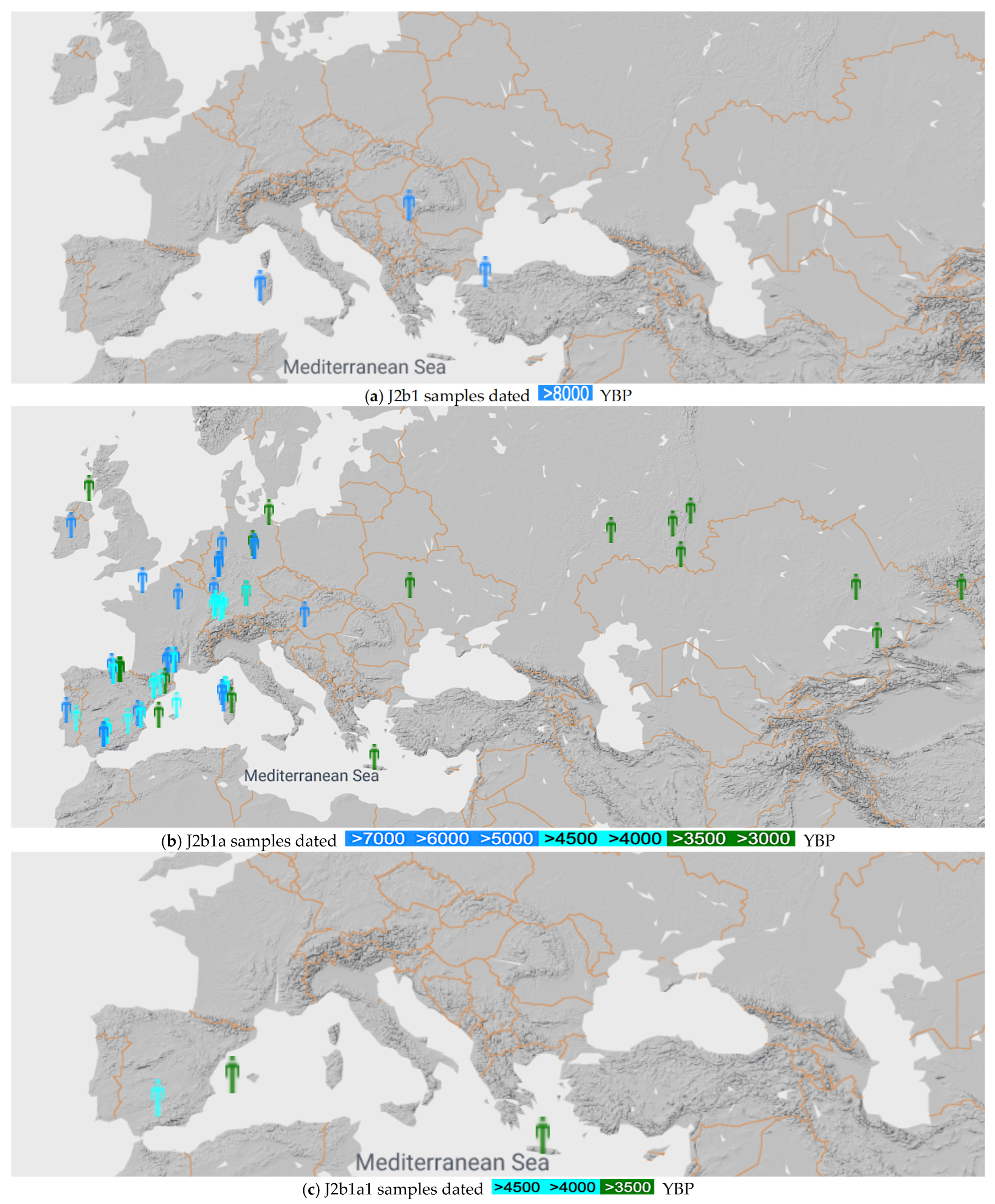
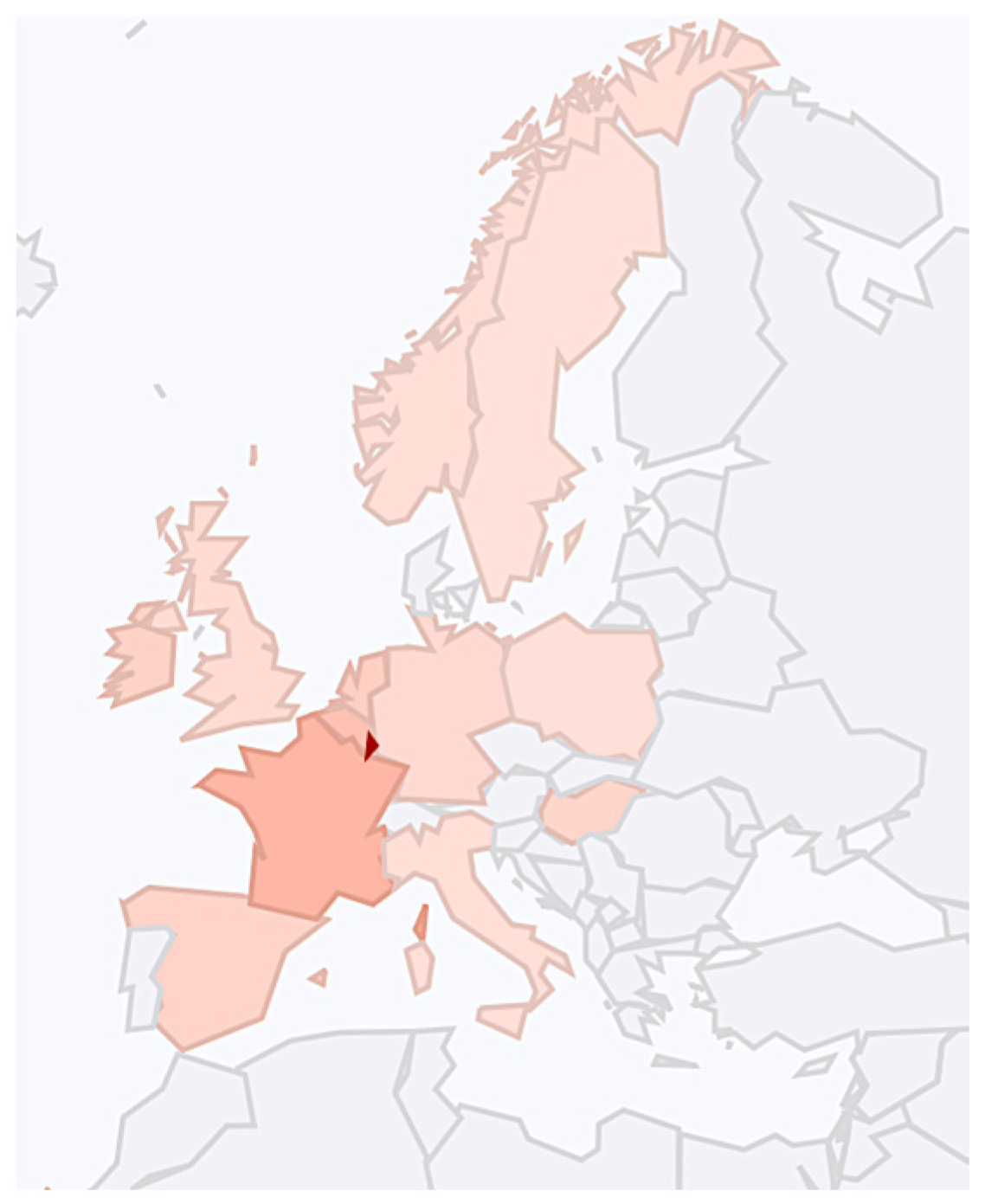

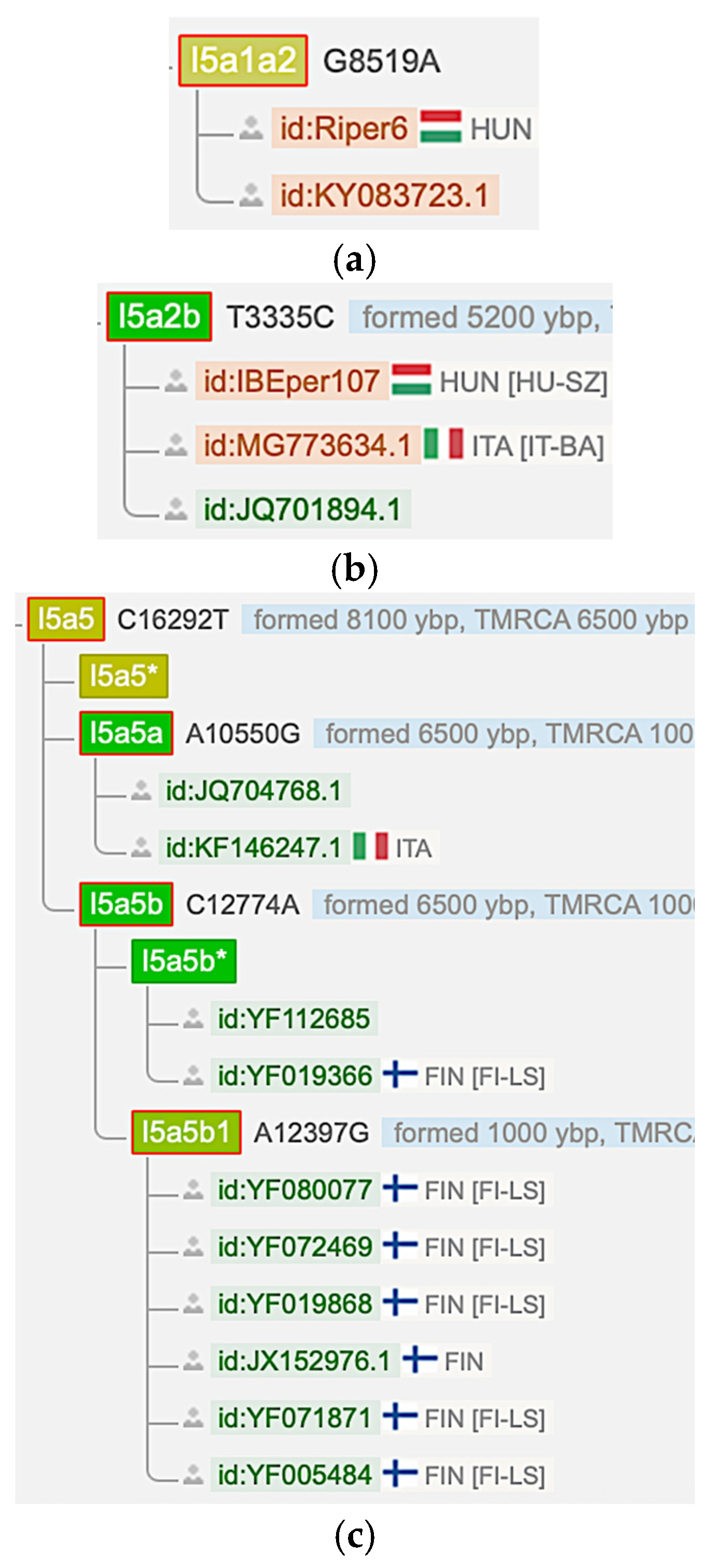
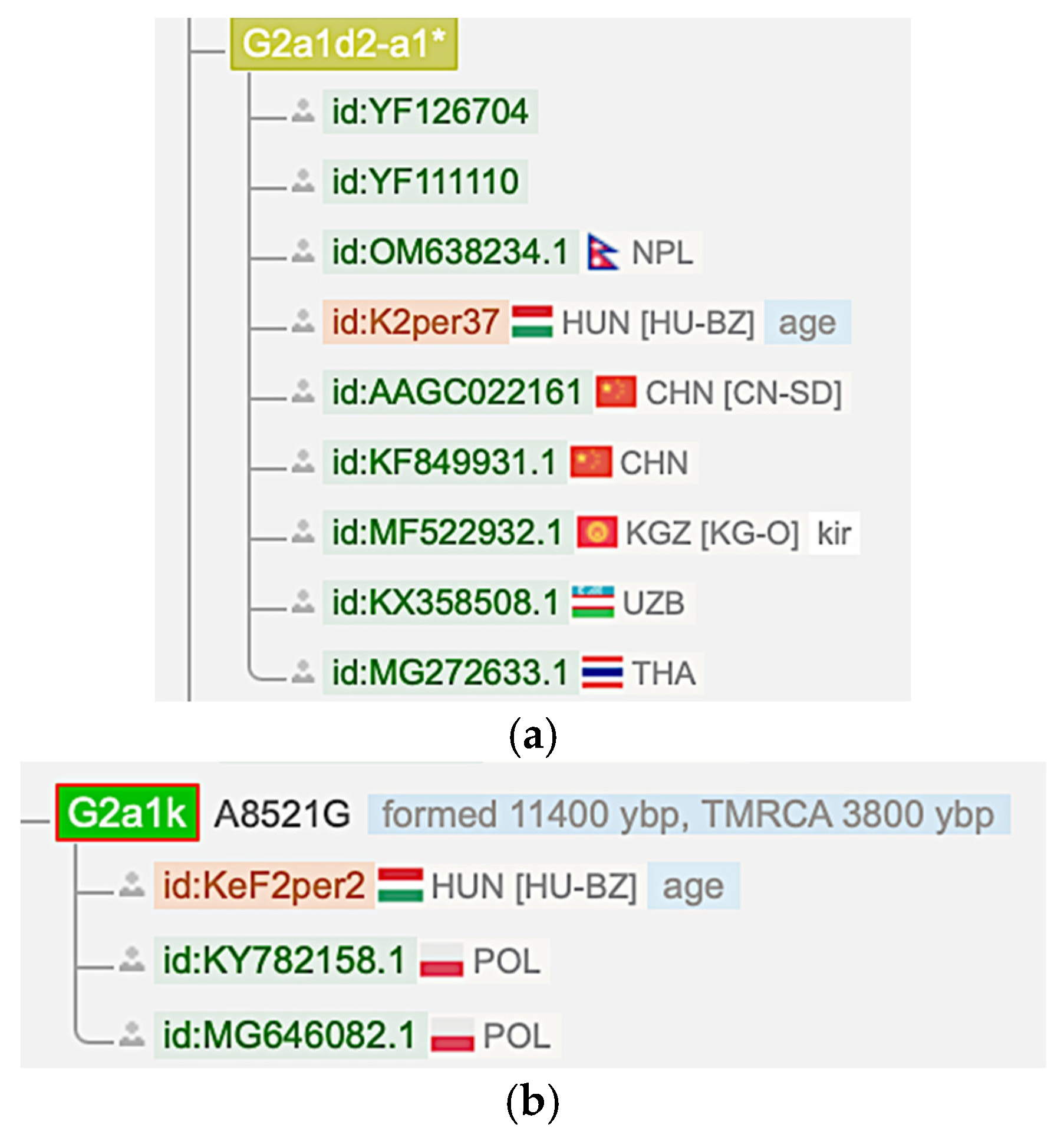
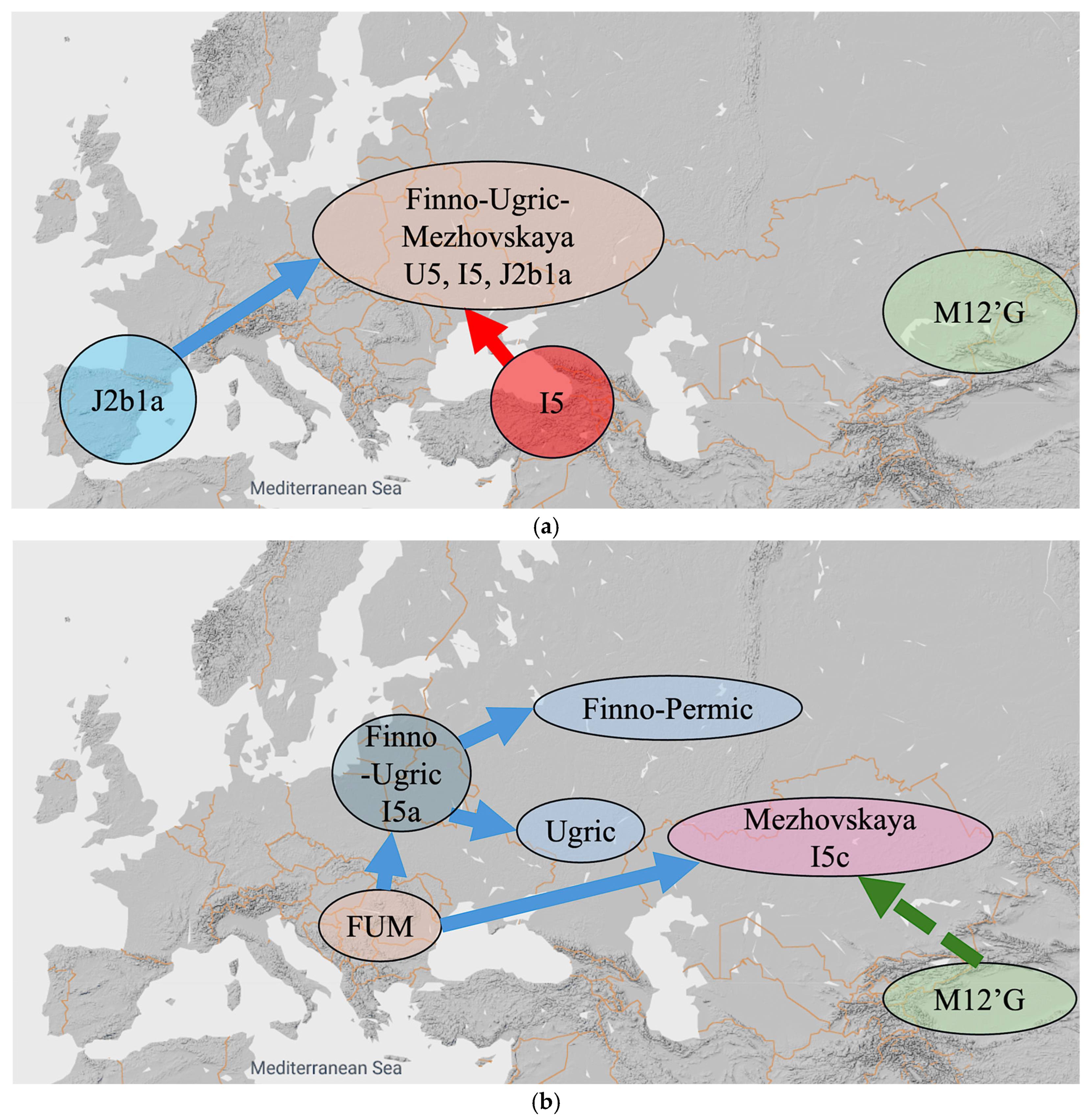
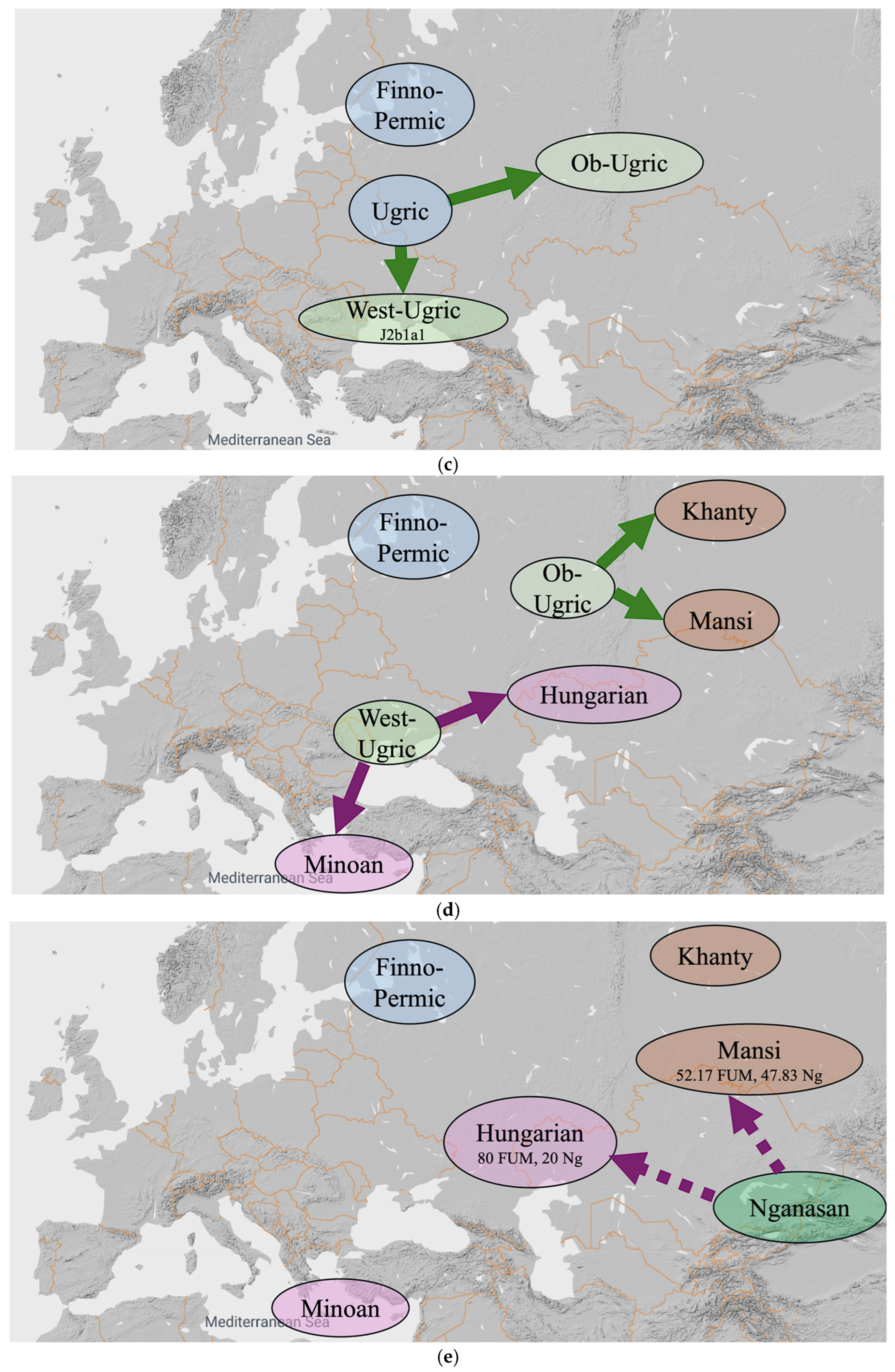

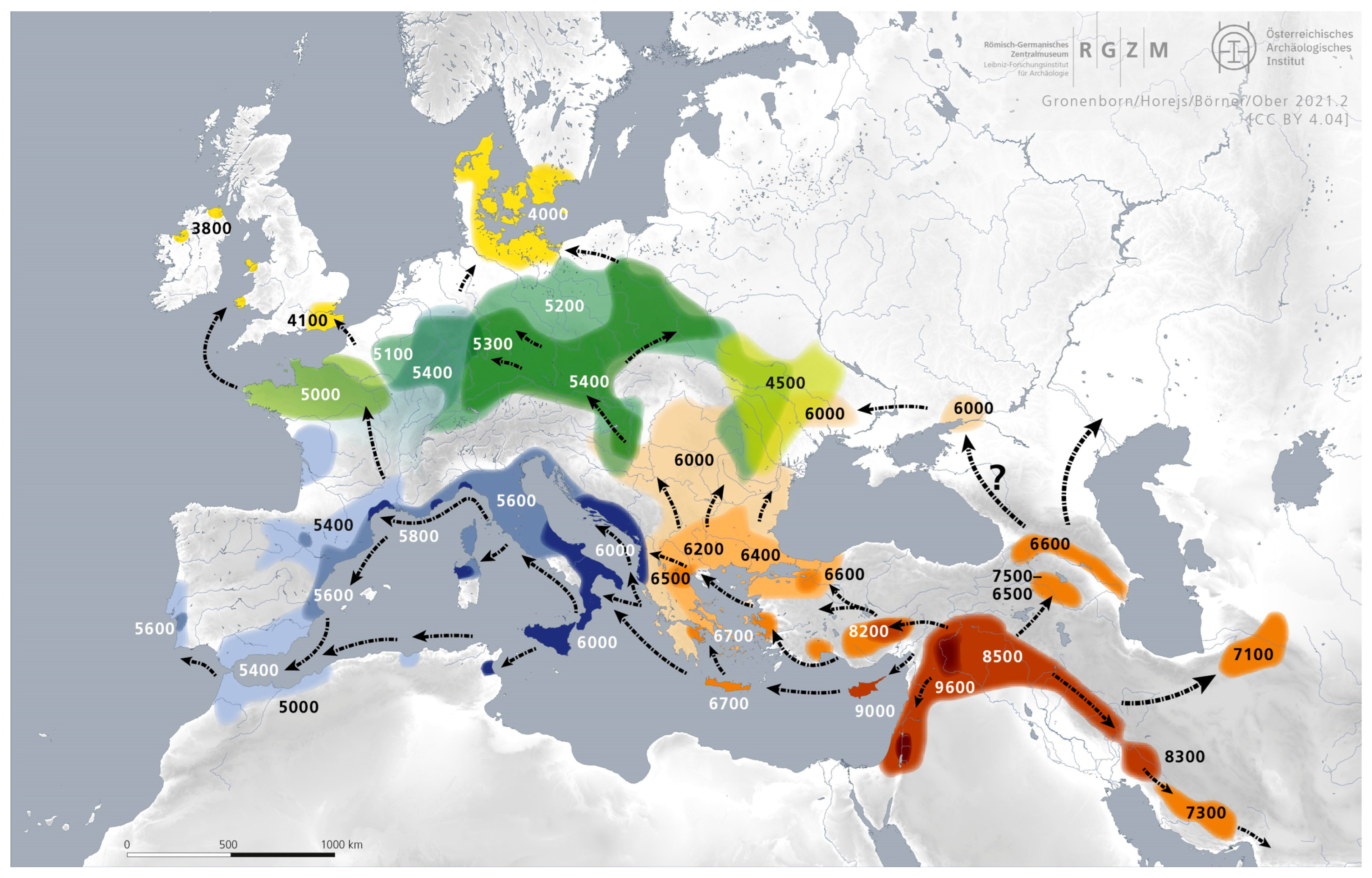
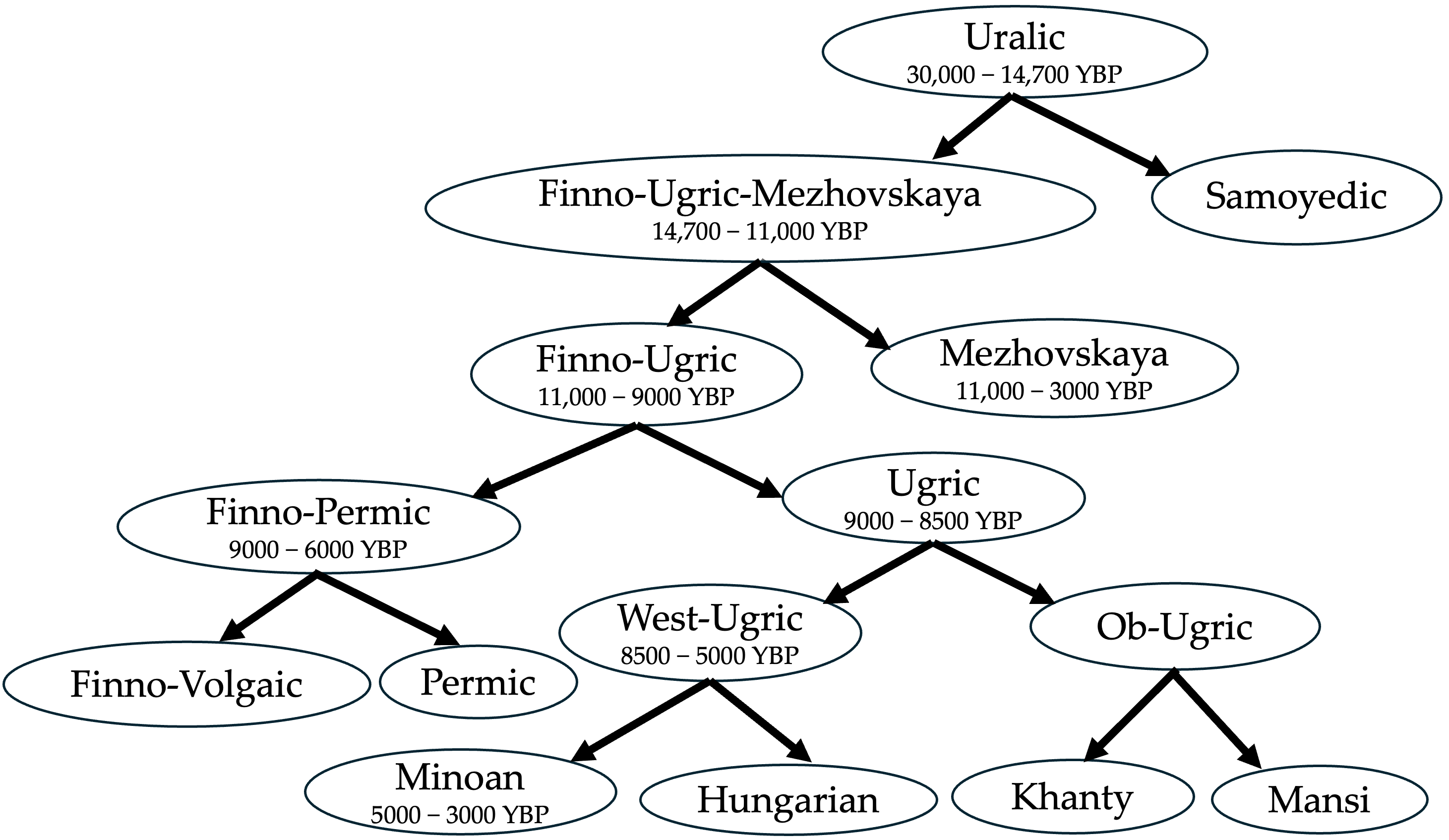
| Reference | Genetic Study Subject | TMRCA |
|---|---|---|
| Pamjav et al. [14] | Y-DNA haplotype R1a-Z280 | 9800 YBP |
| Pamjav et al. [14] | Y-DNA haplotype N-M46 | 7500 YBP |
| Post et al. [15] | Y-DNA haplotype N-B540/L1034 | 4000 YBP |
| Török [24] | qpAdm admixture analysis | after 2700 YBP |
| Source Population | Hungarian Conqueror Admixture Model | Mansi Admixture Model |
|---|---|---|
| Nganasan | 13% | 44% |
| Russia_Mezhovskaya | 52% | 48% |
| Kazakhstan_Eneolithic_Botai | 0% | 8% |
| Mongolia_MLBA | 35% | 0% |
| Total | 100% | 100% |
| Sample ID | Location | mtDNA | YBP |
|---|---|---|---|
| RISE523 | Kapova Cave, Russia | M12′G | 3411 |
| RISE524 | Kapova Cave, Russia | J2b1a | 3000 |
| RISE525 | Kapova Cave, Russia | I5c | 3000 |
| Sample ID | Location | Culture | mtDNA | YBP |
|---|---|---|---|---|
| I1908 | Keszthely-Fenékpuszta, Hungary | Black Sea region | J2b1a | 6050 |
| RISE392 | Stepnoe Cemetery, Russia | Southern Urals | J2b1a2a | 3943 |
| I23210 | Vojvodina, Serbia | Black Sea region | J2b1a1b | 3900 |
| I9127 | Phaistos, Crete, Greece | Minoan | J2b1a1 | 3895 |
| poz094 | Pidlisivka, Ukraine | Black Sea region | J2b1a | 3850 |
| I0423 | Barinovka, Samara, Russia | Southern Urals | J2b1a2a | 3475 |
| I11542 | Guruldek, Kazakhstan | Southern Urals | J2b1a2a | 3250 |
| RISE524 | Kapova Cave, Russia | Russia_Mezhovskaya | J2b1a | 3000 |
| SHper175 | Hajdú-Bihar, Hungary | Hungarian | J2b1a20b | 975 |
| - | Hungary | Hungarian | J2b1a1 | 0 |
| YF065422 | Finland | Finnish | J2b1a* | 0 |
| Sample ID | Location | Culture | mtDNA | YBP |
|---|---|---|---|---|
| OSS.002.B0101 | Nogir, Russia | Black Sea region | I5 | 5756 |
| ART039 | Malatya Province, Turkey | Black Sea region | I5a | 5638 |
| IKI016 | Ikiztepe, Samsun Province, Turkey | Black Sea region | I5 | 5396 |
| SA6013 | Sharakhalsun 6, Russia | Black Sea region | I5b | 5167 |
| I9128 | Phaistos, Crete, Greece | Minoan | I5 | 3895 |
| Minoan #17 | Lasithi, Crete, Greece | Minoan | I5 | 3700 |
| HGC024 | Lasithi, Crete, Greece | Minoan | I5a | 3700 |
| RISE408 | Norabak, Armenia | Black Sea region | I5c | 3050 |
| RISE525 | Kapova Cave, Russia | Russia_Mezhovskaya | I5c | 3000 |
| Riper6 | Békés, Hungary | Hungarian | I5a1a2 | 1000 |
| IBEper107 | Szabolcs-Szatmár-Bereg, Hungary | Hungarian | I5a2b | 975 |
| YF019366 | Finland | Finnish | I5a5b * | 0 |
| mtDNA Haplogroup | Origin YBP | TMRCA YBP | Black Sea >3900 YBP | Finnish modern | Hungarian <1050 YBP | Minoan >3700 YBP | Russia_ Mezhovskaya |
|---|---|---|---|---|---|---|---|
| M12′G | 20,000 | 20,000 | no | no | yes | no | yes |
| I5 | 14,700 | 10,900 | yes | yes | yes | yes | yes |
| J2b1a | 11,300 | 8300 | yes | yes | yes | yes | yes |
| I5a | 10,900 | 8100 | yes | yes | yes | yes | no |
| I5c | 10,900 | 8900 | no | no | no | no | yes |
| J2b1a1 | 8300 | 5800 | yes | no | yes | yes | no |
| English | Protoword [8] | Origin [8] | Hungarian | Origin [31] |
|---|---|---|---|---|
| dog | empε (#1730) | Ugric | eb | Ugric |
| dog | pene (#743) | Finno-Permic | - | - |
| horse | luwε (#1794) | Ugric | ló | Ugric |
| barley | čoše (#1222) | Finno-Permic | árpa | Turkic |
| cow | uskalε (#1669) | Finno-Permic | tehén | Iranian |
| pig, piglet | porśas (#1498) | Finno-Permic | disznó | Turkic |
| sheep | uče (#1086) | Finno-Permic 1 | juh | unknown |
| calf, beef | wetε (#1708) | Finno-Volgaic | borjú | Turkic |
| cow | lešmä (#1378) | Finno-Volgaic | - | - |
| pig | tika (#1644) | Finno-Volgaic | - | - |
| cow, calf | mes (#2137) | Permic | boci | onomatopoeic |
| goat | keć (#2051) | Permic | kecske | Turkic |
| wheat | - | - | búza | Turkic |
Disclaimer/Publisher’s Note: The statements, opinions and data contained in all publications are solely those of the individual author(s) and contributor(s) and not of MDPI and/or the editor(s). MDPI and/or the editor(s) disclaim responsibility for any injury to people or property resulting from any ideas, methods, instructions or products referred to in the content. |
© 2025 by the author. Licensee MDPI, Basel, Switzerland. This article is an open access article distributed under the terms and conditions of the Creative Commons Attribution (CC BY) license (https://creativecommons.org/licenses/by/4.0/).
Share and Cite
Revesz, P.Z. Data Mining Archaeogenetic and Linguistic Data Gives an Improved Chronology of the Uralic Language Family. Information 2025, 16, 930. https://doi.org/10.3390/info16110930
Revesz PZ. Data Mining Archaeogenetic and Linguistic Data Gives an Improved Chronology of the Uralic Language Family. Information. 2025; 16(11):930. https://doi.org/10.3390/info16110930
Chicago/Turabian StyleRevesz, Peter Z. 2025. "Data Mining Archaeogenetic and Linguistic Data Gives an Improved Chronology of the Uralic Language Family" Information 16, no. 11: 930. https://doi.org/10.3390/info16110930
APA StyleRevesz, P. Z. (2025). Data Mining Archaeogenetic and Linguistic Data Gives an Improved Chronology of the Uralic Language Family. Information, 16(11), 930. https://doi.org/10.3390/info16110930






